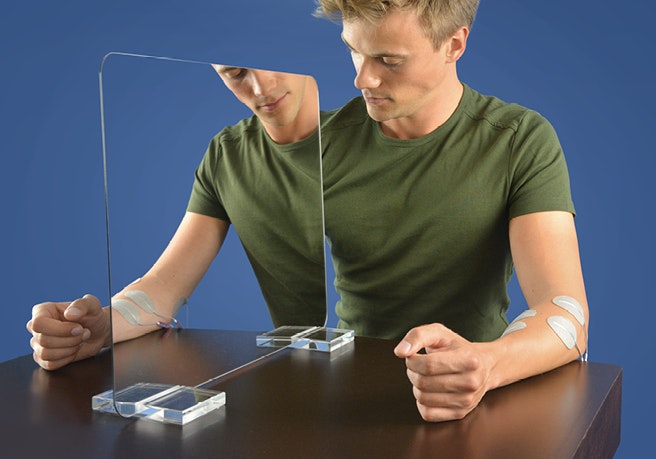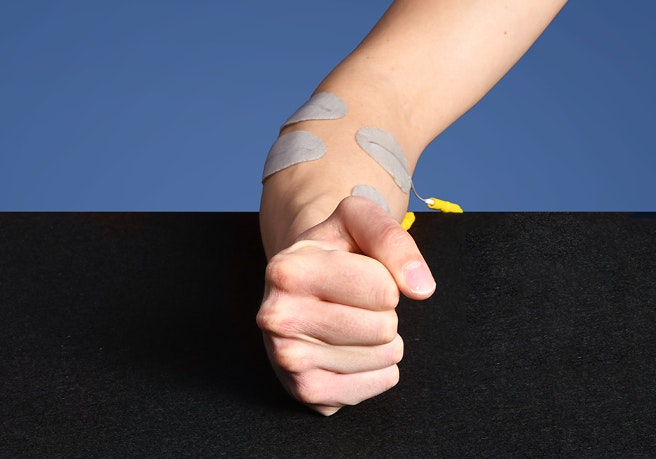Complex regional pain syndrome (CRPS)
CRPS, formerly known as Sudeck atrophy, is a disproportionate inflammatory response (swelling, redness, pain, etc.) following an injury. The inflammation is not limited to the site of the damage, but spreads over an entire area. The disease affects forearms and hands or feet.
What treatment or therapy methods are available and what are the long-term chances of recovery? Definition, numbers, causes, and diagnosis at a glance ...
What is CRPS?
Complex regional pain syndrome (ICD code: M89.0-, G57, G56) (CRPS) is also called Sudeck’s atrophy, Sudeck’s disease, Sudeck’s syndrome, algodystrophy, reflex neurovascular dystrophy, reflex sympathetic dystrophy, amplified musculoskeletal pain syndrome, shoulder-hand syndrome or causalgia.
The phenomenon, first described by a Hamburg surgeon Paul Sudeck in the early 20th century, is a post-traumatic occurrence of swelling, pain, and circulatory disorders, which cause weakness and restricted movement. In the case of CRPS, these symptoms are too severe to be explained by the initial trauma. Typically, the symptoms affect an entire area (e.g. forearm and hand), and are not limited to the injury location (e.g. elbow).
This chronic neurological disease affects only the limbs, i.e. hands or feet. Hands are affected twice as often as the feet. Rapid symptomatic treatment is recommended due to the limitations
in everyday life and the severe emotional stress caused by pain.

Causes/pathogenesis of CRPS
The cause of CRPS has not yet been fully clarified. Since the CRPS usually develops after tissue injuries, it is assumed that an impaired wound healing process plays a role. An excess of neurotransmitters that are released at the beginning of the wound healing process (inflammatory mediators) is suspected to be the trigger. This causes a disruption of the autonomous (unconscious) and central nervous system (brain).
The autonomic nervous system controls involuntary functions (such as digestion or heartbeat) in the body. It consists of the sympathetic and parasympathetic nervous system. The sympathetic nervous system controls activation processes (flight response); the parasympathetic nervous system controls regeneration processes (phases of rest).
Tissue inflammation causes overstimulation of the sympathetic nervous system, which leads to impaired regulation of vessels and glands, and impaired pain perception. This incorrect control causes the characteristic symptoms of the disease. Swelling, pain, and fibrosis in turn impair wound healing and further irritate the sympathetic nervous system. This adverse cycle is probably the reason why the disease persists for a long time before it can be healed.
It has been established that the disease affects the processing of somatosensitive stimuli (sensory information) in the brain, which could be the reason for the severe pain.
Risk factors
CRPS occurs more often between the ages of 40 and 60, with women more likely to be affected than men. Although little is known about the causes of the disease, some factors that may favour the development of CRPS have been identified.
These factors include:
- fractures near the joints
- nerve injuries
- painful setting of joints (repositioning manoeuvre)
- long-standing pain following bone fractures
- constricting dressings following injuries
Statistically, CRPS develops in 2-5% of patients following nerve injuries in the limbs, and in 1-2% of patients following fractures. Forearm fractures (radius fractures) trigger CRPS most often. The disease may also develop following surgery, which is also a form of tissue injury.
However, the extent of the injury bears no relation to the extent of CRPS. Even minor injuries may cause severe symptoms. On the other hand, large tissue damage may heal without causing the disease. Occasionally, the disease may also appear spontaneously
without any identifiable trauma.
The disease affects more women than men, between 40 and 60 year of age. Skin, bone, and nerve injuries, as well as persistent post-traumatic pain and constricting dressings may favour the development of CRPS.
Classification
CRPS can be classified according to the trigger or the disease progression. The classification by trigger has two categories:
- CRPS type I - trauma with no evidence of nerve injury
Damage to the soft tissue and/or bones, or a long-term immobilisation is determined as the cause. However, an injury to peripheral nerves cannot be established. For example, CRPS type I after a distal radius fracture. - CRPS type II - trauma with evidence of nerve injury
This form of CRPS is triggered by damage to the bone or soft tissue in connection with damage to the peripheral nerve.
Regardless of the cause, the disease progresses in different stages. There are three stages: acute, dystrophic, and atrophic.
Learn more about the respective stages and the progression of CRPS
Another possible classification refers to the skin temperature at the onset of the disease. If the skin is cold and bluish (livid), it is a primarily cold CRPS, which occurs in 30% of cases. The remaining 70% of patients have warm, inflamed skin at the
onset of the disease (Bruehl et al. 2016).
Symptoms of CRPS
The affected limb is impaired in several functional areas. This means that sensitivity (feeling), motor skills (movement), or the autonomous (involuntary) nervous system may be affected. The disruption of these components causes the characteristic symptoms of CRPS with severe chronic pain, swelling, redness, impaired blood circulation, and sweating. Over time, these symptoms cause a restricted movement and muscle atrophy (muscle wasting) in the affected area (hand or foot).
The disease may cause the following disorders:
Somatosensory disorders
- chronic pain (also during periods of rest)
- increased sensitivity to pain (hyperalgesia)
- sensation of pain, even with stimuli that are normally not painful (allodynia)
- hypersensitivity to touch (hyperaesthesia)
- abnormal sensations (dysaesthesias)
Motor disorders
- limited passive and active mobility (due to swelling, stiffening/contractures and pain)
- limited fine motor skills (if the hands are affected)
- decreased strength (mostly due to pain)
- tremor (muscle contractions) or, rarely, dystonia (involuntary tensing)
Autonomic disorders
- altered skin circulation, skin temperature, and skin colour; from redness and heat build-up to blue colouring and a sensation of cold
- fluid retention or swelling (oedema)
- impaired sudomotor function: altered sweat secretion or increased perspiration
- trophic disorder: asymmetric growth of hair, nails, and skin (hyperkeratosis or thin and shiny skin)
Bone changes
- stiffening of joints (especially in the wrists and fingers)
- spotty bone decalcification (after weeks to months)

Progression of CRPS
The progression of CRPS has three clinical stages: acute inflammatory, dystrophic, and atrophic. The different stages are characterised by different symptoms (Beckmann & Köck 2011):
Stage I - inflammatory
- Onset: acute following the triggering event (hours to weeks)
- Duration: a few weeks to months
- Symptoms: pain at rest (deep/burning/piercing); adaptive posture leading to stiffness; hyperalgesia; hyperaesthesia; allodynia; reddish livid, moist, and warm skin; swelling
Stage II - dystrophy
- Onset: after 3 to 7 months
- Duration: 3 to 6 months
- Symptoms: less pain at rest; pain on movement; rigid/stiff muscles; muscle atrophy (chronic dystrophy); increasing joint stiffness; skin pale livid, cool and dry with trophic disorders (nails/hair); palmar/plantar fibrosis (formation of connective tissue)
- X-ray findings: patchy decalcification
Stage III - atrophy
- Onset: usually after 8 months
- Duration: several months to years
- Symptoms: often irreversible; stiffening of joints (contractures); muscle wasting (atrophy); complete loss of function in the affected limb; anhidrosis (inability to sweat); skin thin (atrophic) and shiny
- X-ray findings: permeative osteoporosis
Generally, most patients will have primarily warm CRPS. In some cases, the skin may be bluish (livid) in the first stage, and the limb may feel cold. This form is called primarily cold CRPS.
Prognosis/chances of recovery of CRPS
The progression of CRPS varies from person to person. On average, the disease lasts for a year, sometimes longer. The symptoms may then either completely disappear, or they may persist causing permanent disability and pain. Primarily cold CRPS usually has a worse prognosis in terms of the outcome (Vaneker et al. 2005).
A more positive prognosis can be given if there are no complicating factors, and the therapy is started immediately. Painful therapeutic procedures, unjustified invasive measures, and the concomitant psychological symptoms have a negative impact on the
progression. Post-traumatic stress symptoms and general anxiety symptoms should thus be examined and treated as soon as possible (Birklein et al. 2018).

CRPS is a clinical diagnosis that can be supported by instrumental measures (e.g. temperature measurement, X-rays, or scintigraphy).
Diagnosis: CRPS
CRPS is a clinical diagnosis. It is made based on the case history (medical history) and a clinical neurological examination. The diagnosis can be confirmed according to special clinical criteria (symptoms of the stages), and once other diseases have been ruled out as the cause of symptoms.
Instrumental tests (temperature measurement, determination of excessive tenderness to pressure, etc.) may be used to confirm the diagnosis in doubtful cases. Additional examinations, such as X-rays or scintigrams (nuclear medical examination) are particularly helpful at a later stage to show bone changes. Psychological assessments are also useful due to the negative impact of concomitant psychological diseases on the progression of CRPS.
Therapy of CRPS
(Birklein et al. 2018)
Systemic pharmacological therapy
This means that the medication reaches the entire body via the blood, which can be compared to taking an antibiotic for flu. CRPS can be treated with various preparations (bisphosphonates, steroids, N-acetylcysteine, etc.) via infusions or in tablets to relieve pain and improve function, and to reduce inflammation and/or swelling.
Topical pharmacological treatment
This means local therapy, as opposed to systemic treatment. The active ingredient is applied directly to the part of the body or the organ to be treated. In the case of CRPS, a cream (active ingredient: dimethyl sulfoxide) is applied to the affected limb.
Interventional therapy
In contrast to conservative pharmacological treatment, this form of therapy involves targeted interventions on the damaged tissue.
Since the sympathetic nervous system is assumed to play a role in CRPS, implants such as sympathetic nerve blocks and spinal ganglia stimulators are used to inhibit the sympathetic nervous system. Since all of these measures are associated with greater risk (surgery, injury due to injection), they should only be carried out in specialist hospitals, after a positive test stimulation/injection, and only if the conservative treatment (medicines & physiotherapy/occupational therapy) has failed.
Psychotherapy
Psychotherapeutic measures should be used for concomitant psychological diseases, or even if there is no improvement over a longer period of time despite the symptomatic treatment. The focus is usually on treating the anxiety. Possible strategies include crisis intervention, self-awareness techniques, relaxation and imagination techniques, or cognitive interventions to overcome movement anxiety.
Other therapies
There is currently insufficient evidence to support the use of calcitonin and the intravenous administration of immunoglobulins. Repetitive transcranial magnetic stimulation (rTMS) may be used to inhibit the affected area, but it has no lasting
effect. Since long-term therapy is not viable, this treatment cannot be recommended either. Due to insufficient published evidence, plasmapheresis (aphaeresis) cannot be recommended at the moment, despite the initial positive results.
The long-term treatment is an adequate pain medication in combination with rehabilitative measures (such as physiotherapy), and psychotherapeutic measures if required. Other measures, such as interventional therapy, should only be considered if the conservative treatment fails.
Treatment of CRPS
Occupational therapy & physiotherapy
An interdisciplinary therapy that is tailored to the needs of the patient is essential in the treatment of CRPS. Physiotherapy mainly supports mobility. The patient is encouraged to move independently, despite the pain, in order to reduce rigidity (contractures) as much as possible. However, ignoring the pain completely, in the sense of a ‘pain exposure physical therapy’, does not appear to be useful (Barnhoorn et al. 2015).
Specific forms of therapy, such as mirror therapy, ‘graded motor imagery’, and ‘exposure in vivo’ improve the interaction of sensory and movement information in the brain. With regular use, even in self-training, the function and pain improve so that everyday movements can be performed with more ease.
Occupational therapy provides special daily routine training. The aim is to make the affected limb get used to everyday sensations again. Occupational therapy also trains fine motor skills and provides aids.
In addition to occupational therapy and physiotherapy, regular lymphatic drainage may be carried out to reduce swelling (oedema).

Electrical stimulation in combination with mirror therapy for pain relief

Functional electrical stimulation of forearm muscles to reduce swelling
Electrotherapy
Depending on the symptoms and stage of the CRPS, early functional therapy is particularly important in order to prevent stiffening, maintain functions, and reduce pain and swelling. Functional electrical stimulation (FES) can meet these requirements.
Depending on the clinical presentation of the CRPS, there are different therapy options:
- functional training/movement exercises
- strength building
- stimulation of the lymphatic drainage mechanism
- sensory stimulation to reduce pain & improve sensations
- improvement of trophism
Some electrical stimulation devices also allow independent training at home. Self-training with electrotherapy allows for short repeated units of exercise. Twitching without movement can be provoked by varying the current strength, pulse widths, and frequencies, which makes it easier to practice below the pain threshold.
EMG-triggered multi-channel electrical stimulation (EMG MES) helps in relearning activities that require fine motor skills. EMG MES can also be combined with mirror therapy. This combines the advantages of both therapies.
If you are interested in continuing education on functional electrical stimulation and wish for a STIWELL® training directly at your institute or online, please contact us
Find out how functional electrical stimulation with the STIWELL® can be used to treat CRPS.
Barnhoorn, K. J., van de Meent, H., van Dongen, R. T., Klomp, F. P., Groenewoud, H., Samwel, H., ... & Staal, J. B. (2015). Pain exposure physical therapy (PEPT) compared to conventional treatment in complex regional pain syndrome type 1: a randomised controlled trial. BMJ open, 5(12), e008283.
Beckmann, J. & Köck, F. (2011) Komplexes regionales Schmerzsyndrom. In: Grifka, J. & Kuster, M. (Hrsg.). Orthopädie und Unfallchirurgie. Berlin Heidelberg: Springer-Verlag.
Birklein F. et al. (2018). S1-Leitlinie: Diagnostik und Therapie komplexer regionaler Schmerzsyndrome (CRPS). In: Deutsche Gesellschaft für Neurologie (Hrsg.). Leitlinien für Diagnostik und Therapie in der Neurologie. Online: https://www.dgn.org/images/red_leitlinien/LL_2018/PDFs_Download/030116_LL_CRPS_2018.pdf (abgerufen am 11.09.2018).
Bruehl, S., Maihöfner, C., Stanton-Hicks, M., Perez, R. S., Vatine, J. J., Brunner, F., ... & Livshitz, A. (2016). Complex regional pain syndrome: evidence for warm and cold subtypes in a large prospective clinical sample. Pain, 157(8), 1674-1681.
Vaneker, M., Wilder-Smith, O. H., Schrombges, P., de Man-Hermsen, I. & Oerlemans, H. M. (2005). Patients initially diagnosed as ‘warm’ or ‘cold’ CRPS 1 show differences in central sensory processing some eight years after diagnosis:
a quantitative sensory testing study. Pain, 115(1-2), 204-211.

